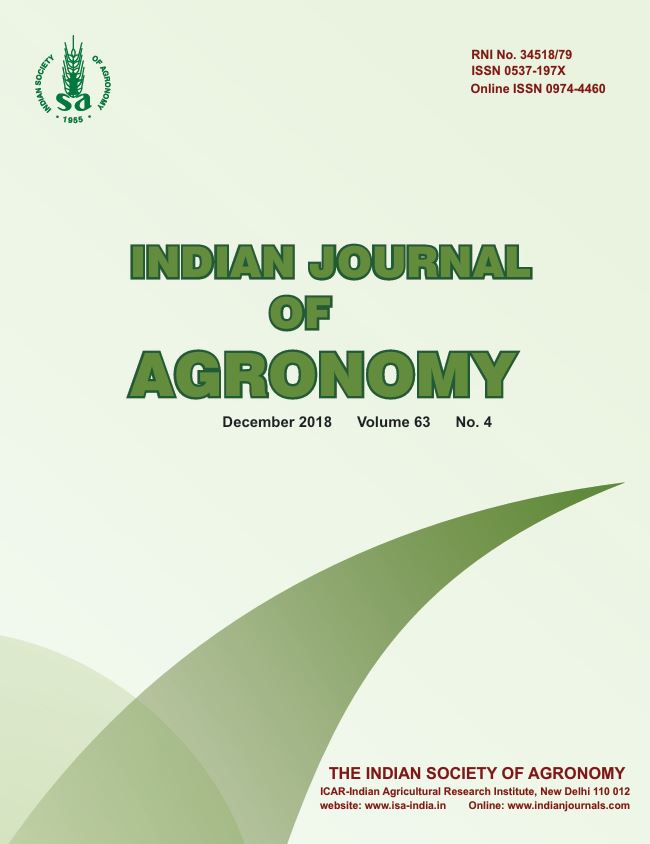GreenSeeker-based nitrogen scheduling in wheat (Triticum aestivum) for higher nitrogen-use efficiency and productivity
DOI:
https://doi.org/10.59797/ija.v63i4.5678Keywords:
Agronomic efficiency, Economics, Green Seeker, Leaf-area index, Nitrogen scheduling, N uptake, NDVI, PAR interception, Wheat, YieldAbstract
A field experiment was conducted during winter (rabi) season of 2014–15 and 2015–16 at Ludhiana, Punjab to study the effect of nitrogen scheduling using GreenSeeker on growth, productivity and nitrogen-use efficiency (NUE) of wheat (Triticum aestivum L.). The soil of the experimental field was loamy sand, low in organic carbon and available nitrogen and medium in available phosphorus and potassium. The experiment was conducted in complete randomized block design with eight treatments, viz. control, recommended N application (150 kg /ha) in 3 equal splits (50 kg N at sowing : 50 kg N at first irrigation : 50 kg N/ha at second irrigation), 3 treatments with fertilizer application in 3 splits up to 2nd irrigation using optical sensor GreenSeeker (GS) : 60 kg N/ha + GS2nd irri (30 : 30 : 61/51 kg/ha), 84 kg N/ha + GS2nd irri (42 : 42 : 53/46 kg/ha), 120 kg N/ha + GS2nd irri (60 : 60 : 44/41 kg/ha) and 3 treatments with fertilizer application in four splits i.e. upto 3rd irrigation using GreenSeeker : 60 kg N/ha + GS3rd irri (20 : 20 : 20 : 14/20 kg/ha), 84 kg N/ha + GS3rd irri (28 : 28 : 28 : 6/20 kg/ha), 120 kg N/ha + GS3rd irri (40 : 40 : 40 : 6/ 13 kg/ha). Treatment 120 kg N/ha + GS 2nd or 3rd irrigation had resulted in better growth and yield of wheat. Application of 160–164 kg N/ha with GreenSeeker at 2nd irrigation (60 kg N at sowing + 60 Kg N at first irrigation + 40/ 44(GS) kg N/ha) recorded higher but statistically similar grain yield in comparison to the blanket application of 150 kg N/ha. Delayed application of N GreenSeeker up to third irrigation (40 : 40 : 40 : 6/13 kg N/ha) resulted in N saving of 17–24 kg/ha, upto 59.5% N recovery and 2.5% higher grain yield than 150 kg N/ha application.
References
Anonymous. 2016. Package of Practices for Rabi Crops. pp 1–20. Punjab Agricultural University, Ludhiana.
Fageria, N.K. 1992. Maximizing crop yields. New York Marcel Dekker.
Guarda, G., Padovan, S. and Delogu, G. 2004. Grain yield, nitrogen use efficiency and baking quality of old and modern Italian bread wheat cultivars grown at different nitrogen levels. European Journal Agronomy 21(2): 181–192.
Kaur, H., Ram, H., Sikka, R. and Kaur, H. 2016. Productivity, agronomic efficiency and quality of bread wheat [Triticum aestivum (L.)] cultivars in relation to nitrogen. International Journal of Agriculture Environment and Biotechnology 9(1): 101–106.
Kharub, A.S. and Chander, S. 2010. Effect of nitrogen scheduling on wheat productivity and quality under alternate tillage practices. Indian Journal of Agricultural Sciences 80(1): 29–32.
Krupnik, T.J., Six, J., Ladha, J.K., Paine, M.J. and Van, K.C. 2004. An assessment of fertilizer nitrogen recovery efficiency by grain crops. In : Agriculture and the nitrogen cycle: Assessing the impacts of fertilizer use on food production and the environment (SCOPE 65) (Eds) Mosier, A.R., Syers, J.K., Freney, J.R. pp. 193–208. Island Press, London.
Kumar, D., Singh, R.A. and Singh, Y. 2016. Influence of sowing dates and nitrogen scheduling on growth behavior and productivity of late sown wheat (Triticum aestivum) in north Indian plains. Annals Agricultural Research 37(1) : 61–65.
Majumdar, K., Jat, M.L., Pampolino, M., Dutta, S. and Kumar, A. 2013. Nutrient management in wheat: current scenario, improved strategies and future research needs in India. Journal of Wheat Research 4(1): 1–10.
Pradhan, S., Bandopadhyay, K.K., Sahoo, R.N., Sehgal, V.K., Singh, R., Joshi, D.K. and Gupta, V.K. 2013. Prediction of wheat (Triticum aestivum) grain and biomass yield under different irrigation and nitrogen management practices using canopy reflectance spectra model. Indian Journal of Agricultural Sciences 83(11): 1,136–1,143.
Ratanoo, R., Kumar, S., Dhaka, A.K., and Singh, B. 2016. Nitrogen management in irrigated wheat (Triticum aestivum) using optical sensor GreenSeeker. Indian Jornal of Agronomy 61(1): 105–108.
Singh, B., Sharma, R.K., Kaur, J., Jat, M.L., Martin, K.L., Singh, Y., Singh, V., Chandna, P., Choudhary, O.P., Gupta, R.K., Thind, H.S., Singh, J., Uppal, H.S., Khurana, H.S., Kumar, A., Uppal, R.K., Vashistha, M., Raun, W. and Gupta, R. 2011. Assessment of the nitrogen management strategy using an optical sensor for irrigated wheat. Agronomy for Sustainable Development 31(3): 589–603.
Singh, S., Malik, R.K., Garg, R., Devraj, R., and Sheoran, P. 2012. On-farm nitrogen use pattern in rice-wheat cropping system of the trans-gangetic plains of india. Cereal Research Communications 40(1): 122–134.
Zhao, H. and Si, L. 2015. Effects of topdressing with nitrogen fertilizer on wheat yield, and nitrogen uptake and utilization efficiency on the Loess Plateau. Acta Agriculturae Scandinavica, Section B — Soil and Plant Science 65(8): 681–687.






